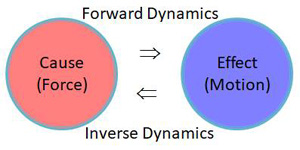Home > Foundation > Kinematics vs. Kinetics
Kinematics vs. Kinetics
Kinematics and kinetics are sub-areas of biomechanics. Kinematics is the study of description of motion while kinetics is the study of explanation of motion. In kinematics, the focus is on the motion of the object, while kinetics focuses on the cause of motion dealing with the 'why.'
For example, in the study of golf swing, kinematics focuses on details of the swing 'motion' such as the shape of the clubhead path, positions of the body and club at various swing events, velocities of the body parts and club, and the timing of slow-down of the body for speed-up of the club. In order to describe the swing motion objectively, it is important to accurately measure the motion first. This is why measurement of the motion is one of the central aspects of kinematics. Basic kinematic quantities include time, position, displacement (distance), velocity (speed), and acceleration. In addition to these, shapes of trajectories of various points on the body, club and orientation of motion planes of various body segments and club are also kinematic issues. A complex motion of an object can be resolved into the linear motion of the center of mass (COM) of the body and the angular motion of the body about its COM, which is also a kinematic issue. (See the Linear Motion vs. Angular Motion page for the definitions of linear and angular motion.) The kinematic sequence plot is based on the angular velocity patterns of body segments, lines, and club.
Kinetics focuses on the causes of motion acting on the body: forces for the linear motion and moments of force (torques) for the angular motion. For example, there are largely two different forces acting on the club if we ignore the air resistance: the grip force exerted by the hands to the grip and the gravity (weight of the club). Since the weight of the club remains the same during the swing and always acts downward through club's COM, the grip force is the primary factor that influences club's linear motion. Hands also provide a moment of force to the club about the mid-hand point (a virtual joint that links the hands to the club) which influences club's angular motion. The hand-club interaction, thus, is a key aspect of golf swing kinetics.
In order to explain the motion of an object, one has to know not only the causes of motion acting on the body but also the inertial propeties of the body such as mass and moments of inertia (MOI). Without knowing the inertial properties of the body, it is not possible to relate cause to effect. Newton's 2nd Law of Motion addresses the cause-and-effect relationships (Figure 1).

Figure 1. The cause-and-effect relationship in biomechanics. Effects can be predicted from the causes (forward dynamics) or causes can be assessed from the effects (inverse dynamics).
If all causes acting on the body are known, the effects can be predicted: cause -› effect (Figure 1). This procedure is called 'forward dynamics.' Conversely, if the effect is measured, the cause can be assessed: effect -› cause. This procedure is called 'inverse dynamics.'
Golfer's body is essentially a system of segments linked to each other by the joints. For simplicity, we consider the body segments rigid; i.e. the shapes and mass distributions within the segments do not change during the motion. Joint motions are in fact the building blocks of golfer's swing motion. Measurement of joint motions is a kinematic issue (joint kinematics) while assessment of the interactions (force and moment exertions) between linked segments is a kinetic issue (joint kinetics). A method called 'inverse dynamics' is commonly used in assessing the interactions at the joints. For example, if the mid-hand point (center of the hands) is viewed as a virtual joint that connects the hands to the club, the inverse dynamics approach allows computation of the net force and net moment acting on the club by both hands collectively. (See the Hand-Club Interaction page for details.) Since a large number of joint motions are allowed in the body, it is important to generate joint motions in a well-coordinated and orchestrated manner in order to generate the maximum outcome.